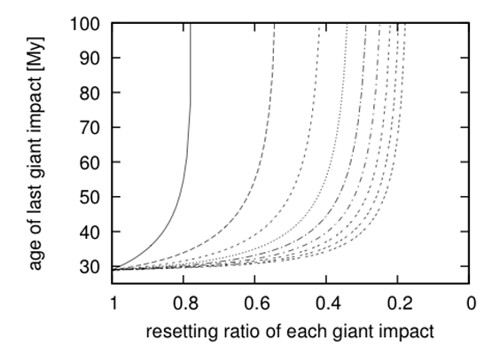Hf-W chronometry provides constraints on the timing of planetary accretion and differentiation, as segregation of a metal core from silicates should induce strong fractionation of Hf from W. In previous studies, it was assumed that a giant impact raise up perfect resetting on Hf-W chronometer. In this study, we showed the difficulty of achieving perfect equilibration of Hf-W system by giant impacts.
To achieve perfect equilibration, iron must be split into small droplets less than meter-scale. However, since the sedimentation velocities of small droplets are slow, the Rayleigh-Taylor instability between the upper metal-containing and the lower metal-free layers results in quick overturn of the layers. Thus, the lower metal-free layers cannot be equilibrated.
Sketch of the Rayleigh-Taylor instability

1st sketch: After a giant impact, the ejecta and broken impactor are mixed each other and accrete to the protoearth as a mixture. Accreted metal in this mixture split into metal droplets, then these droplets sink in mixture layer.
2nd sketch: If these droplets is small enough to achieve perfect equilibration, the mixture layer that holds samll metal droplets, upper layer in first sketch, is equilibrated of Hf-W system. Then next, the Rayleigh-Taylor instability between the mixture layer with metal droplets and silicate melt layer of metal free occurs immediately because the growth of the Rayleigh-Taylor instability is by far faster than the Stokes sedimentation of metal droplets.
3rd sketch: Once the Rayleigh-Taylor instability has grown, the mixture layer with metal droplets sink into the core as a cluster, thus the equilibrated layer and non-equilibrated layer counterchange immediately.
4th sketch: On this occasion, metal droplets in mixture layer cannot interact with silicate outside the cluster. Thus, there exists two regions in the mantle such as equilibrated region (last sketch, lower layer) and non-equilibrated region (last sketch, upper layer).
We calculated the isotopic evolution of Hf-W system in consideration of partial resetting of this chronometer. Our study provided three implications: (1) collision conditions and the number of the giant impact events affect the age estimation of the core formation, (2) the Earth’s W isotope ratio indicates that more than two-tenth of the volume of protoearth’s mantle must be equilibrated at each giant impact, and (3) Mars should have experienced a late extensive equilibration event that involve metal-silicate more than three-tenth volume of Mars’ mantle, which is potentially a single giant impact.
The age of the last giant impact for the Earth

The age of the last giant impact as a function of the resetting ratio of each giant impact for fitting the observational W data of Earth’s samples. The number of giant impacts is 2 to 10 from left to right.

Be the first to comment